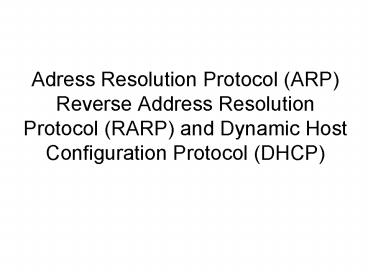Adress Resolution Protocol ARP Reverse Address Resolution Protocol RARP and Dynamic Host Configurati - PowerPoint PPT Presentation
1 / 16
Title:
Adress Resolution Protocol ARP Reverse Address Resolution Protocol RARP and Dynamic Host Configurati
Description:
Ex 1: A- B tranmission: A resolves B's MAC address based on B's IP address ... D transmission: A resolves Y1's MAC address based on Y1's IP address, Y1 ... – PowerPoint PPT presentation
Number of Views:516
Avg rating:3.0/5.0
Title: Adress Resolution Protocol ARP Reverse Address Resolution Protocol RARP and Dynamic Host Configurati
1
Adress Resolution Protocol (ARP) Reverse Address
Resolution Protocol (RARP) and Dynamic Host
Configuration Protocol (DHCP)
2
Address resolution
- Transmission on LANs requires knowledge of
destination hardware address (physical address,
MAC address). - On a LAN hardware addresses are unique.
- Address resolution is translation of destination
IP address to destination hardware address
3
Address Resolution
Network1
Network2
Network3
- Ex 1 A-gtB tranmission A resolves Bs MAC
address based on Bs IP address - Ex 2 A-gtD transmission A resolves Y1s MAC
address based on Y1s IP address, Y1 resolves
Y2s MAC address based on Y2s IP address, Y2
resolves Ds MAC address based on Ds IP address.
4
Address Resolution Methods
- Table look-up
- Each node keeps a separate table
- Network adress part of IP address need not be
stored. - If address mapping changes all nodes update their
tables
IP address
Physical address (Hardware address)
5
Address Resolution Methods
- Computation
- Derivation from the host address part of IP
address - Useful in network that employ reconfigurable
(dynamical) port address.
Physical address(Hardware address)
IP address
6
Address Resolution Methods
- Message exchange
- A server responds to address resolution request
that it receives - Any machine that knows the hardware address
responds to address resolution request broadcasts
7
Address Resolution Protocol (IP over Ethernet)
- Is based on message exchange
- Is simple.
- Optimizations
- Caching
- A machine broadcasts its own IP-Ethernet binding
- At boot time
- With address resolution request
- ARP message is placed into the payload field of
LAN(DLL) frame.
ARP message
8
The Address Resolution Protocol
- Three interconnected /24 networks two Ethernets
and an FDDI ring.
- Two possibilities for transmissions to other
networks - 65.7 broadcasts ARP request for 63.8, to which
65.1 responds with - (63.8-E3)
- 2. 65.7 realizes 63.8 is on a different network
and binds (63.8-E3)
9
Address Resolution Protocol
- ARP request message (broadcast)
- ARP response message (unicast)
10
Reverse ARP
- A diskless workstation learns its IP address
based on its Ethernet address - Workstation broadcasts its Ethernet address.
- RARP server responds by table look-up and sending
back the corresponding IP address - Since the operating system image is IP address
independent, a single image kept at a remote
server can be downloaded at boot time. - Since broadcasts are not forwarded by routers a
single RARP server is needed on each network (or
subnet)
11
BOOTP and DHCP
- BOOTP uses UDP messages to forward such requests,
but requires manual configuration (IP
addr.-Ethernet addr. mapping) - DHCP allows automatic IP address assignment, DHCP
server can be on a different network reachable by
a DHCP relay agent. - Leasing To allow unused addresses to be used
again IP address assignment is periodically
performed, those hosts not renewing timely are
not permitted to use IP addresses assigned in the
past.
12
Dynamic Host Configuration Protocol
- Operation of DHCP.
13
IP datagram Encapsulation
- An IP packet (IP datagram) is carried by the
DLL/MAC sublayer frame of the network it passes
over.
Frame Header
Frame Payload
Trailer
14
IP datagram encapsulation
Source
Datagram
- Encapsulation of a datagram that passes over
three networks
Trailer1
Datagram
Header1
Network1
Datagram
Network2
Header2
Trailer2
Datagram
Datagram
Network3
Datagram
Header3
Trailer3
Dest.
Datagram
15
IP datagram fragmentation
- Maximum Transmission Unit Maximum length of data
that a network can carry in the payload field of
a frame - To meet MTU specifications datagrams might have
to be fragmented - All fragments contain the same Identification
field. - Fragments might arrive unorderly at the
destination. - A fragment might be fragmented further.
- If all fragments arrive timely, they are
reassembled at the destination, otherwise
arriving ones are discarded. - Fragment offsets and identification fields are
used in reassembly. - DF Dont fragment (IP packet is not to be
fragemented probably because reordering is not
possible at destination.
16
IP datagram fragmentation
IP Header
IP Payload
IP Payload1
IP Payload2
IP Payload3
IP Header1
IP Header2
IP Header3































